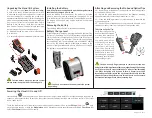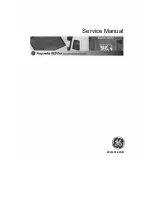
Appendix B: Automatic Measurements Reference
B- 12
CSA8000B & TDS8000B User Manual
Table B- 2: Pulse Measurements - Timing (cont.)
Name
Definition
Rise Time
The time interval between the low-reference level and the high reference level crossings on the
positive slope of the pulse.
RZ Rise Time = TcrossH – HcrossL
Where:
H
TcrossH is the time of crossing of the high reference level.
H
TcrossL is the time of crossing of the low reference level.
The low reference and high reference levels are adjustable and default to 10% and 90% of the
pulse amplitude. There are four Reference Level Calculation methods available for determining
these reference levels. See
Measurement Reference Parameters and Methods
on page B--56 or
in the online help. Also see
Reference Levels Method
on page 3--79.
If enabled, measurement gates constrain the measurement region to the area between the Start
Gate (G1) and Stop Gate (G2). By default the algorithm searches forward from the Start Gate
for the first rising edge, but the Direction of traversal can be reversed, so that the search will be
backward from the Stop Gate. See
To Localize a Measurement
on page 3--83.
RMS Jitter
The time variance on the time crossings of data sampled at the mid-reference level. RMS Jitter
is defined as one standard deviation (
σ
) of that variance.
RMS Jitter = Tcross
σ
Where Tcross
σ
is one standard deviation of the variance of crossing times for a histogram
of the Tcross values. Tcross is the horizontal coordinate of the first positive or negative
crossing.
The mid-reference level is adjustable and defaults to 50% of the pulse amplitude.
The slope can be selected to be the first positive, the first negative, or the first crossing (positive
or negative) in the region.
If enabled, measurement gates constrain the measurement region to the area between the Start
Gate (G1) and Stop Gate (G2). By default, the algorithm searches forward from the Start Gate
for the first falling edge, but the Direction of traversal can be reversed, so that the search will be
backward from the Stop Gate.
This measurement requires the use of a waveform database. When this measurement is turned
on, it will automatically set the measurement system to use a waveform database if available.
See
Use a Waveform Database
on page B--70.
Summary of Contents for CSA8000B Series
Page 4: ......
Page 18: ...Preface xiv CSA8000B TDS8000B User Manual ...
Page 26: ...Check the Package Contents 1 8 CSA8000B TDS8000B User Manual ...
Page 62: ...Accessories and Options 1 44 CSA8000B TDS8000B User Manual ...
Page 76: ...Overview 3 2 CSA8000B TDS8000B User Manual ...
Page 112: ...Acquiring Waveforms 3 38 CSA8000B TDS8000B User Manual ...
Page 126: ...Triggering 3 52 CSA8000B TDS8000B User Manual ...
Page 146: ...Displaying Waveforms 3 72 CSA8000B TDS8000B User Manual ...
Page 174: ...Measuring Waveforms 3 100 CSA8000B TDS8000B User Manual ...
Page 186: ...Creating Math Waveforms 3 112 CSA8000B TDS8000B User Manual ...
Page 214: ...Data Input and Output 3 140 CSA8000B TDS8000B User Manual ...
Page 353: ......
Page 354: ......















































